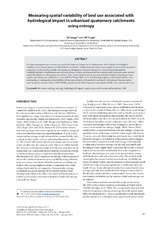| dc.creator | Ilunga, M. | |
| dc.creator | Singh, VP. | |
| dc.date.accessioned | 2017-10-18T16:21:01Z | |
| dc.date.available | 2017-10-18T16:21:01Z | |
| dc.date.issued | 2015-01 | |
| dc.identifier.issn | 1816-7950 (Online) | |
| dc.identifier.issn | 0378-4738 (Print) | |
| dc.identifier.uri | https://hdl.handle.net/1969.1/164634 | |
| dc.description.abstract | Decision making for water resources is needed for land-use change due to urbanisation, which impacts hydrological variables such as mean annual runoff (MAR) of catchments. Urbanisation introduces some degree of uncertainty (expressed as entropy) to this specific variable. This study uses Shannon or theoretic entropy as a tool for measuring land use variability/diversity of urbanised areas in South Africa. Positive correlations between entropy and increase in mean annual runoff (MAR) due to urbanisation are derived. Also, relationships between return period/risk of failure (flooding or water supply) and entropy are established. A case of Pieter Wright Dam of the Vaal drainage region is used to demonstrate these relationships. Consequently, the reliability of this dam is shown to be positively correlated with entropy. Data on surface water resources of South Africa 1990 (WR90) compiled by the Water Resource Commission (WRC) were used in this study. | en |
| dc.language.iso | en_US | |
| dc.subject | decision-making | en |
| dc.subject | entropy | en |
| dc.subject | hydrological impact | en |
| dc.subject | quaternary catchments | en |
| dc.subject | urbanisation | en |
| dc.subject | risk | en |
| dc.title | Measuring Spatial Variability of Land Use Associated with Hydrological Impact in Urbanised Quaternary Catchments using Entropy | en |
| dc.type | Article | en |
| local.department | Biological and Agricultural Engineering (College of
Agriculture and Life Sciences) | en |


